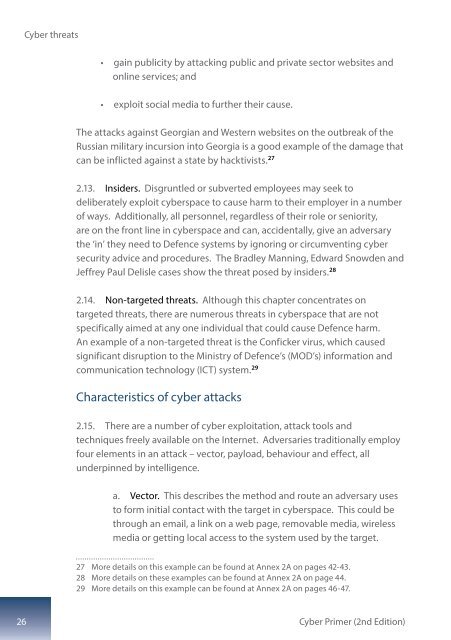Cyber Primer
AEWhbF
AEWhbF
You also want an ePaper? Increase the reach of your titles
YUMPU automatically turns print PDFs into web optimized ePapers that Google loves.
<strong>Cyber</strong> threats<br />
• gain publicity by attacking public and private sector websites and<br />
online services; and<br />
• exploit social media to further their cause.<br />
The attacks against Georgian and Western websites on the outbreak of the<br />
Russian military incursion into Georgia is a good example of the damage that<br />
can be inflicted against a state by hacktivists. 27<br />
2.13. Insiders. Disgruntled or subverted employees may seek to<br />
deliberately exploit cyberspace to cause harm to their employer in a number<br />
of ways. Additionally, all personnel, regardless of their role or seniority,<br />
are on the front line in cyberspace and can, accidentally, give an adversary<br />
the ‘in’ they need to Defence systems by ignoring or circumventing cyber<br />
security advice and procedures. The Bradley Manning, Edward Snowden and<br />
Jeffrey Paul Delisle cases show the threat posed by insiders. 28<br />
2.14. Non-targeted threats. Although this chapter concentrates on<br />
targeted threats, there are numerous threats in cyberspace that are not<br />
specifically aimed at any one individual that could cause Defence harm.<br />
An example of a non-targeted threat is the Conficker virus, which caused<br />
significant disruption to the Ministry of Defence’s (MOD’s) information and<br />
communication technology (ICT) system. 29<br />
Characteristics of cyber attacks<br />
2.15. There are a number of cyber exploitation, attack tools and<br />
techniques freely available on the Internet. Adversaries traditionally employ<br />
four elements in an attack – vector, payload, behaviour and effect, all<br />
underpinned by intelligence.<br />
a. Vector. This describes the method and route an adversary uses<br />
to form initial contact with the target in cyberspace. This could be<br />
through an email, a link on a web page, removable media, wireless<br />
media or getting local access to the system used by the target.<br />
27 More details on this example can be found at Annex 2A on pages 42-43.<br />
28 More details on these examples can be found at Annex 2A on page 44.<br />
29 More details on this example can be found at Annex 2A on pages 46-47.<br />
26<br />
<strong>Cyber</strong> <strong>Primer</strong> (2nd Edition)


